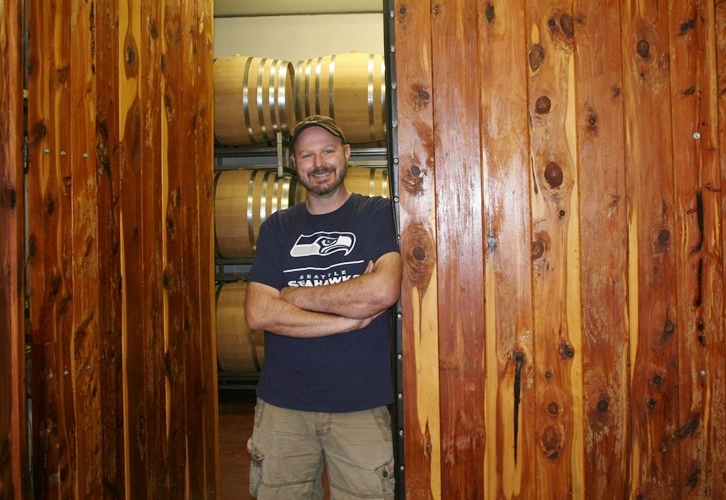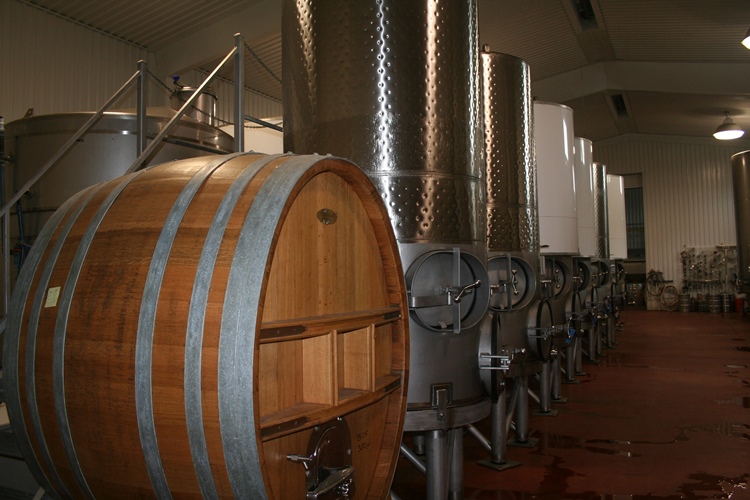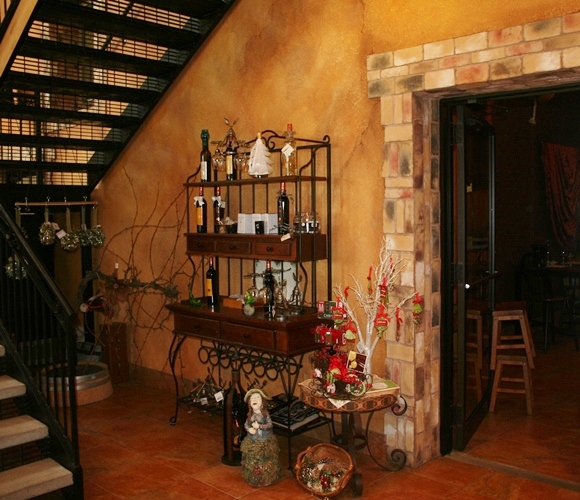In the middle of 2011’s grape harvest, Flat Creek Estate lost its winemaker to a rival in California. Desperate to save the vintage, owners Rick and Madelyn Naber asked Tim Drake, then an itinerant wine scientist running Texas Wine Lab, for help. Drake turned out to be a winemaker in search of a winery.
Since then, the wines produced at Flat Creek — and the vineyard where estate grapes are grown — have been under Drake’s purview.
The Nabers’ goal had always been to make world-class wines. Once they settled on wine as the product, anyway. They bought what was known as Flat Creek Farm on East Singleton Bend Road to save the agricultural land from development in 1999.
The first block of vines was planted in 2000 after the Nabers decided against other projects, like growing mushrooms or farming frogs. That made Flat Creek Estate just the 37th winery in post-Prohibition Texas. According to Drake, who now lives in Point Venture, “It took sixty people six hours to plant six thousand vines.”
In the Vineyard
The very speed at which those vines were planted may have caused a few troubles down the line, as Drake struggles to keep them healthy in the hostile growing environment of the Hill Country. He’s made some changes to the way the vineyard is run, focusing on sustainability.
Instead of toxic fungicide, Drake sprays ozonated water to keep the grapes free of mildew. All waste from the winemaking process is composted and spread to fertilize the grapes. And beneficial organisms now abound in the soil.
“You should see the earthworms,” Drake says, enthused. “And ladybugs.” He’s built purple martin houses, has a line on some peafowl chicks, and plans are in the works to construct a bat hotel.
Still, plagues like phylloxera, cotton root rot, and Pierce’s disease take their toll. Ever the scientist — he studied chemical oceanography at the University of Washington — Drake is glad to host trials done by Texas A&M University. One such trial has resulted in an immunization against the insidious cotton root rot.
“Over three years,” Drake says, “we lost 60% of the vines in one block to cotton root rot.” Just 72 hours after symptoms appear, the vine is dead. It happens when conditions are right for the underground fungus to send out deadly tendrils that strangle roots.
Drake has high hopes for the vaccination. He also welcomes modern delivery methods that target chemical medicine directly where it’s needed. “We supply it through a drip,” he says. “It doesn’t harm insects or other plants that way.”
In the Fermentation Room
Getting juicy grapes from the vineyard into temperature-controlled vats in the fermentation room no longer requires villagers and stomping. Stainless steel machinery designed by German and Italian engineers helps at every turn.
In addition to grapes grown on the estate and in Marble Falls, Drake uses grapes from the High Plains of Texas, where growing conditions are ideal for some varietals. But those grapes are machine harvested. “They come in these plastic bins that hold half a ton,” he explains, pointing out the first stage. “You sort as they go up the table so you can pick out leaves and stuff.”
From there the bunches go into a stemmer, another work-saving invention. It’s a perforated stainless steel drum with soft rubber fingers inside that pop the grapes from the stems. “I’ve tried doing this by hand,” Drake says. “I did a five-gallon bucket in about 45 minutes. That’s about 30 pounds of grapes.” It’s tedious, tiring work, he admits. “This thing does twelve tons an hour. I love this thing.”
After stemming, the grapes go to the sorting table. “Seeds and raisins will fall down through the slots and get discarded,” Drake says, pointing to a slotted conveyor belt. “We’ll have four or five people standing there picking out green grapes or bits and pieces of stem that made it through so we can have almost all berries.”
Then those berries are off to the crusher and the fermentation tanks. For white wine, the skins are removed and juice alone is fermented. “We press the juice out and ferment it really cold and slow,” Drake explains. Doing it that way allows delicate whites to develop those “nice floral notes . . . a little grapefruit or Bosque pear.”
Red wine ferments in contact with the skins. “It’s like a tea bag. All the color and flavors and everything are in the skins,” Drake says. As yeast does its work, it generates CO2 that floats the skins up to the top. To make sure the wine gains all the color and flavor from contact with the skins, Drake does the modern version of punching them down. “We pump the wine from the bottom back over the top and sprinkle it back on, like a percolator.”
In the Barrel
Once the red wine is fermented, it’s separated from the skins and placed in barrels in an underground vault. Wood and earth and fruit and yeast combine to give the barrel room a rich aroma unlike any other.
Flat Creek Estate is building a bocce court above the barrel room, which is naturally cool. “In 2012 when we had that series of 100 days over 100 degrees, our chiller went down and we had no air conditioning,” Drake recalls. “It went from 58 degrees to 68 degrees, that’s it.”
One of the functions of the barrel’s shape is to settle out the solid yeast cells, called the lees, left from fermentation. “Over the course of a year it settles and concentrates along the center.” Drake can siphon off the clean wine, wash the sediment out of the barrels, and put the wine back in. After two years, he says the wine’s usually clean enough you don’t need to filter it.
Every barrel — there are three hundred in the room — has a cooper’s mark that tells where the wood came from and who made the barrel.
Most of the barrels used are made with Hungarian or French oak. The different oaks impart flavor into the wine. “French oak will give you kind of a vanilla flavor and maybe a little toasted brioche. American oak gives you coconut and depending on where it’s grown it can also give you dill weed,” Drake says. He’s partial to the subtly spicy, smoky flavors provided by Hungarian oak. “It respects the wine,” he says.
Every vintage and varietal has some variation. “I can’t control really the details of the wine, whether it’s raspberry or blueberry or whatever,” Drake points out. “What I can control is the mouth feel and the tannin structure, depending on how I ferment it and how I age it in the barrel. I can adjust those parameters.” He lets everything else go with the flow.
In the Bottle
Drake’s wife is in the wine business, too. She represents a company that makes capsules, the foil tops that cover the cork. Flat Creek Estate whites are bottled with screw caps because they stay fresh that way, but the reds need time in the bottle to age gracefully.
If you drink red wine, you may have noticed that many modern corks are not the same as they used to be. That’s because of a cork taint epidemic. The expensive natural corks were turning, giving off a wet-cardboard smell upon opening the bottle.
Drake explains that Flat Creek Estate is going to a technical cork for the red wines. It’s made of a polymer that breathes like natural cork does but is not susceptible to cork taint because it’s sterile. “The problem with a lot of the technical corks is they either didn’t breathe at all or they breathe too much — they let too much oxygen through.”
Like a regular cork, Drake says, this polymer “allows a lot of oxygen through at first, and then it tapers off to no oxygen. And that’s how a natural cork functions.” The new polymer is made with sugarcane pulp and comes with a zero-carbon footprint. Drake points out that “wineries all over the place are always trying to be sustainable.”
In the Glass
If you come out to Flat Creek Winery, a tasting flight of six one-ounce pours — you can choose red or white — is yours for $15. The production tour (RSVP here), which includes a “diva tasting” of six wines, is $17.50.
The Tasting Room offers more than just wine. A local artist has a table of handmade jewelry for sale at the entrance, and the gift shop displays other products — from delicious homemade salad dressing to souvenir coaster tiles.
A diva tasting is perfect for two people who don’t mind sipping from the same glass. That way one of you can get the red-wine tasting flight and one the white, and you can share. You’re given a tasting sheet, and the Flat Creek expert pouring for you is prepared to answer any questions about food pairings or grape provenance.
When you leave the Tasting Room, a souvenir glass is wrapped up for you. If you don’t decide to take a bottle or two home as well you’re made of strong stuff.
Whether you lean toward delicate Viognier, almond-scented bubbly, or rich and full Sangiovese, Flat Creek Winery likely has a bottle you’ll love. You might even decide to join the wine club. And you’ll savor the knowledge, along with the wine, that you know where it comes from.





